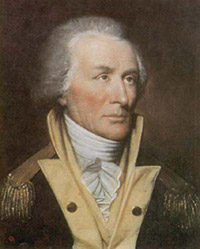Lecture tells how Thomas Sumter took Banastre Tarleton down
October 5, 2021Most folks have never heard of the Battle of Blackstock’s Plantation.
“Most have heard of the American Revolution,” Charles Baxley ironically acknowledges. But too few of them understand how important South Carolina was in winning that war, or the critical role that what happened at Blackstock’s played in setting up the key victory at Cowpens.
Baxley will help broaden knowledge about all that at noon on Friday, Oct. 29, at the South Carolina Confederate Relic Room and Military Museum in Columbia, where he will deliver a free lecture titled “Gen. Thomas Sumter’s Magnum Opus: The Battle of Blackstock’s Plantation.”
Blackstock’s is where Sumter defeated the supposedly unbeatable Banastre Tarleton, one of the King’s most feared officers in the colonies at the time. Baxley will put all that into perspective, and also reveal new insights discovered in the modern mapping of the battle site.
“The British gave us such a perfect villain” in Tarleton, says Baxley. He really helped motivate patriots in South Carolina. “You need a character that’s not too remote to vilify.” We had King George, but Tarleton was right there in front of us. He came south with the reputation of an aggressive commander, and once he was here, he developed a dark reputation for brutality, murdering surrendered prisoners and otherwise spreading fear of his name.
And he had already beaten Sumter once, at Fishing Creek. In fact, he had nearly captured the American.
Sumter would have a rough day at Blackstock’s Farm as well, in what today is Union County, a few miles from Cross Anchor, on Nov. 20, 1780. He was seriously wounded. But he emerged victorious, and Tarleton found himself beaten by American backcountry militia. The humiliation was sufficient that he lied about it in his report to Lord Cornwallis, claiming victory and overemphasizing Sumter’s wounding.
But Sumter had won, and it mattered. Tarleton had seemed invincible before this encounter, but that myth was now gone. Partisans from North Carolina, South Carolina, and Georgia beat him and British regulars of the 63d Regiment, along with the feared British Legion cavalry. The Americans lost three killed, against 45 on the British side. The momentum of that victory led to the larger one at Cowpens a few weeks later.
And the “Fighting Gamecock” Sumter had proved his mettle.
Charles Baxley is an attorney with the Lugoff firm of Baxley, Pratt & Wells, P.A. He is a recipient of the Order of the Palmetto. He is editor and publisher of the online Southern Campaigns of the American Revolution, and the Chairman of the South Carolina American Revolution Sestercentennial Commission. He gives battlefield tours, and has worked with the South Carolina Battleground Preservation Trust to map 20 Revolutionary War battlefields in the Carolinas and to plan new battlefield parks at Camden, Blackstock’s Plantation, and Moncks Corner.
His lecture is part of the museum’s Lunch and Learn series. As always, the lecture is free to the public, and attendees are welcome to bring a lunch to enjoy while they listen.
About the South Carolina Confederate Relic Room and Military Museum
Founded in 1896, the South Carolina Confederate Relic Room and Military Museum is an accredited museum focusing on South Carolina’s distinguished martial tradition through the Revolutionary War, Mexican War, Civil War, Spanish-American War, World Wars I and II, Vietnam, the War on Terror, and other American conflicts. It serves as the state’s military history museum by collecting, preserving, and exhibiting South Carolina’s military heritage from the colonial era to the present, and by providing superior educational experiences and programming. It is located at 301 Gervais St. in Columbia, sharing the Columbia Mills building with the State Museum. For more information, go to https://crr.sc.gov/.














